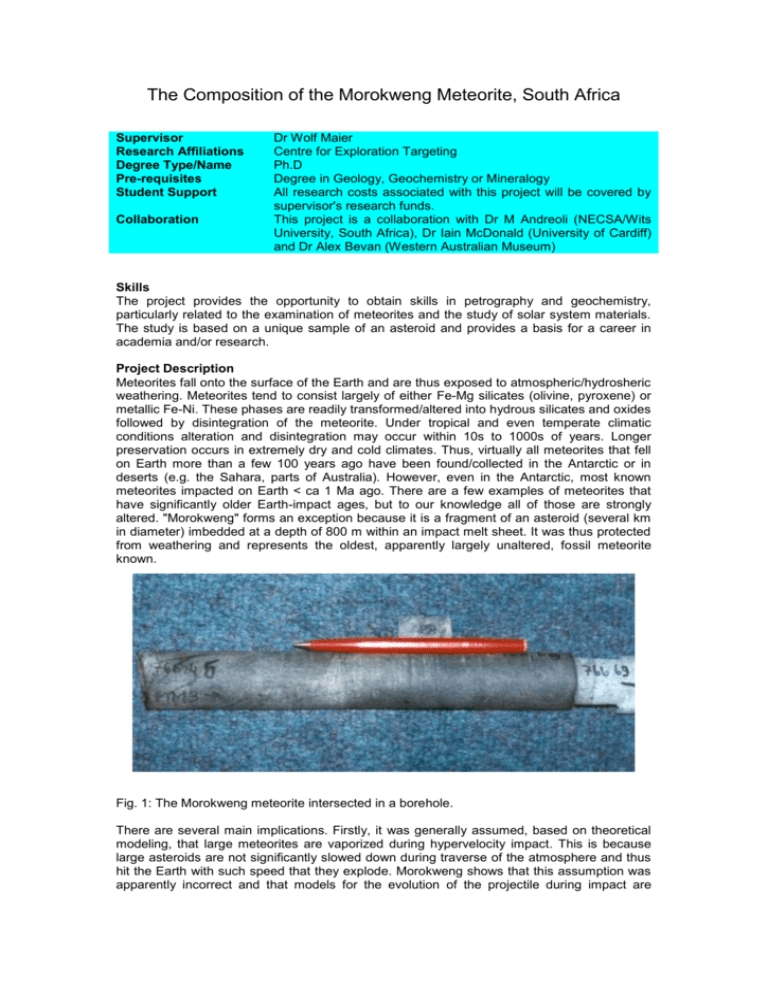The Composition of the Morokweng Meteorite, South Africa
advertisement

The Composition of the Morokweng Meteorite, South Africa Supervisor Research Affiliations Degree Type/Name Pre-requisites Student Support Collaboration Dr Wolf Maier Centre for Exploration Targeting Ph.D Degree in Geology, Geochemistry or Mineralogy All research costs associated with this project will be covered by supervisor's research funds. This project is a collaboration with Dr M Andreoli (NECSA/Wits University, South Africa), Dr Iain McDonald (University of Cardiff) and Dr Alex Bevan (Western Australian Museum) Skills The project provides the opportunity to obtain skills in petrography and geochemistry, particularly related to the examination of meteorites and the study of solar system materials. The study is based on a unique sample of an asteroid and provides a basis for a career in academia and/or research. Project Description Meteorites fall onto the surface of the Earth and are thus exposed to atmospheric/hydrosheric weathering. Meteorites tend to consist largely of either Fe-Mg silicates (olivine, pyroxene) or metallic Fe-Ni. These phases are readily transformed/altered into hydrous silicates and oxides followed by disintegration of the meteorite. Under tropical and even temperate climatic conditions alteration and disintegration may occur within 10s to 1000s of years. Longer preservation occurs in extremely dry and cold climates. Thus, virtually all meteorites that fell on Earth more than a few 100 years ago have been found/collected in the Antarctic or in deserts (e.g. the Sahara, parts of Australia). However, even in the Antarctic, most known meteorites impacted on Earth < ca 1 Ma ago. There are a few examples of meteorites that have significantly older Earth-impact ages, but to our knowledge all of those are strongly altered. "Morokweng" forms an exception because it is a fragment of an asteroid (several km in diameter) imbedded at a depth of 800 m within an impact melt sheet. It was thus protected from weathering and represents the oldest, apparently largely unaltered, fossil meteorite known. Fig. 1: The Morokweng meteorite intersected in a borehole. There are several main implications. Firstly, it was generally assumed, based on theoretical modeling, that large meteorites are vaporized during hypervelocity impact. This is because large asteroids are not significantly slowed down during traverse of the atmosphere and thus hit the Earth with such speed that they explode. Morokweng shows that this assumption was apparently incorrect and that models for the evolution of the projectile during impact are currently incomplete. In particular, lower impact velocities need to be considered, or perhaps the meteorite comes from the trailing edge of an asteroid. Secondly, a reconnaissance study (Maier et al., 2006) has shown that Morokweng is of an unusual composition. It is relatively depleted in siderophile elements (Ni, Co, platinum-group elements) and it is of a higher metamorphic grade than most other ordinary chondrites resulting in the absence of metallic iron. This could suggest that Morokweng comes from a previously unknown interior portion of the LL chondrite parent body. Further, it is tempting to suggest that the unusual composition of Morokweng is related to the fact that it impacted on Earth much earlier than other meteorites examined so far. In other words, the meteorites that have impacted on Earth during the last 1 Ma or so may not represent the full range of asteroid compositions. For example, previous studies on Antarctic meteorites have suggested that the relative proportions of different meteorite types impacting on Earth can change over relatively short periods of time following major asteroidal collision events. Fig. 2: (a) Porphyrytic opx chondrule. (b) Excentroradial opx chondrule. (c) An additional small meteorite fragment in the meltsheet. The present project aims to study Morokweng in detail, using e.g. state of the art microanalytical equipment at UWA, including high-resolution ion probe (nanoSIMS). The student will characterize the nature and composition of the various mineral phases, using petrography, major and trace element geochemistry as well as isotopic systems (notably oxygen, noble gases, Sm-Nd). This work will hopefully provide an explanation for the unusual composition of Morokweng, and an improved understanding of the composition of the solar system. Recommended Reading W. D. Maier, M. A. G. Andreoli, I. McDonald, M. D. Higgins, A. J. Boyce, A. Shukolyukov, G. W. Lugmair, L. D. Ashwal, P. Gräser, E. M. Ripley and R. J. Hart: Discovery of a 25-cm asteroid clast in the giant Morokweng impact crater, South Africa, Nature V 441, Nr. 7090, p203-206.











